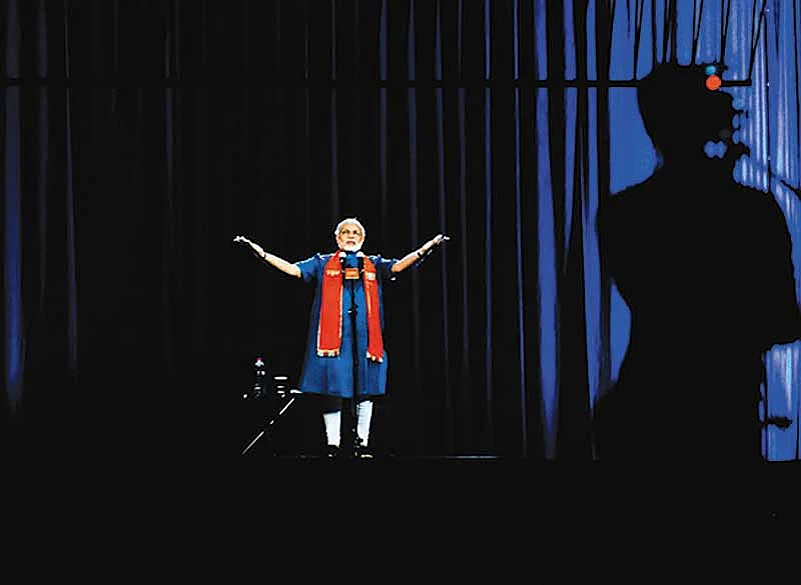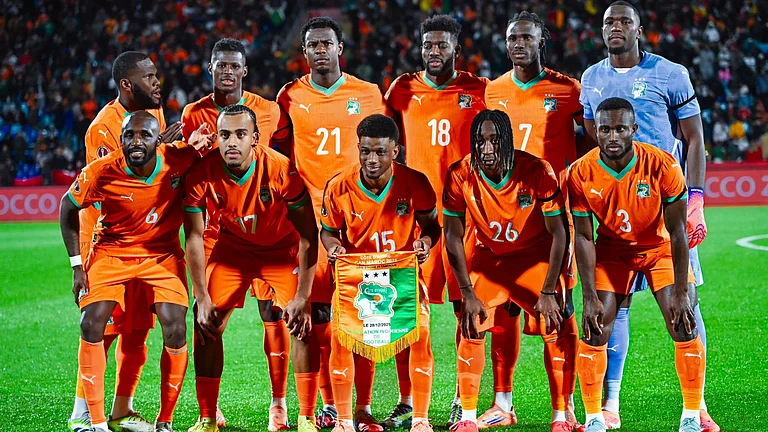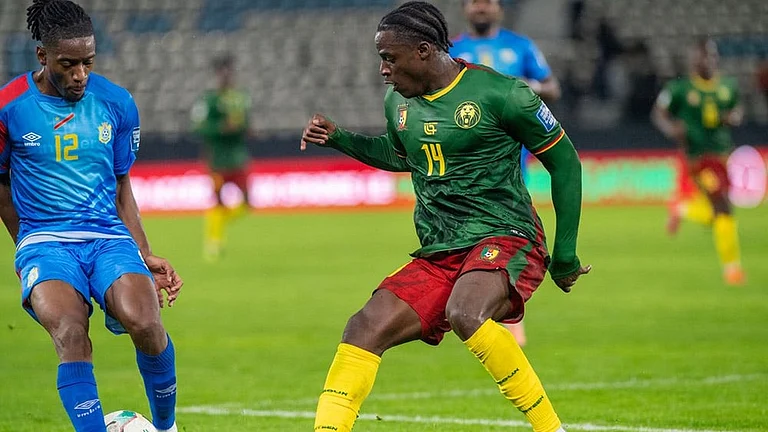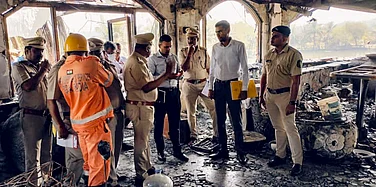Gujarat Poll Waltz
| BJP | Congress | |
|
| |
***
In Ahmedabad, there is a buzz in the local media that Narendra Modi is in trouble. But travel into the interiors of Gujarat and it appears he may have no trouble at all in winning a third term. The CM talks quite often of the “Delhi sultanate”. He himself is quite the sultan of Gujarat.
That said, there is a democratic process to be followed for another anointing. The election till now has been quite bereft of sound and fury except for the early burst in September-October when Modi took off on his Vivekananda rath. Since then, he’s been engaged mostly in deciding candidates and managing constituencies. Now he will hit the campaign trail again and the drama will start unfolding.
There is already a mood of quiet certainty. A day after the announcement of the party’s second list, the election office of the BJP in Khanpur in Ahmedabad is unusually quiet. Heads buried deep in their laptops, party officials are busy sending out e-mails to the media about the schedules of various candidates. Some others are keeping a close watch on the news on TV and the progress of the Congress campaign. It’s an office-in-waiting, much like the rest of Gujarat, for Modi to begin his rigorous on-the-road campaign in Saurashtra (it goes to the polls first, on December 13).

GPP’s Keshubhai Patel in Surat
The going has been slow till now, with even the official BJP stall, selling saffron banners, flags and other trinkets complaining about lean sales: not even a badge or banner on some days, and it’s been two months since they set shop. Inside the three-storey party office, the confidence that Modi will take Gujarat by storm yet again is overwhelming: “Abhi tak jalwa nikla hi kahan hai bahar? Let Narendrabhai hit the campaign trail and you will see how this election moves then,” Jagdish Bhavsar, the BJP media cell head, tells us.
From Ahmedabad to far-flung Sasan Gir, Modi’s name resounds like a chant through the barren landscape. For a man who hasn’t hit the campaign trail physically yet, he is already omnipresent. Fifty kilometres away from the glitter of Modi’s showpiece city Ahmedabad, Viramgam is everything that Ahmedabad is not. A small village, some distance away from Sanand where the famous Tata Nano plant has been set up, Viramgam is still struggling to find employment for its local youth. Tata Nano, villagers say, has been able to provide only 3,000 jobs in an area with a population of over 50,000. It remains a big concern with the locals.
Blistering even under an afternoon winter sun, villagers crowd to speak their mind and the roadside chai shop turns into an open, impromptu audit of Modi’s decade-long rule. “The local BJP leader here is no good but Modi has given us electricity, water and roads. Chun ke toh Modi hi aayega,” says 50-year-old Ishwar Bhai. Quiz him on the employment problem and he says, “Everything can’t be fixed immediately. It takes time. Modi will do it.”

Ex-home minister Amit Shah campaigning
Listening in, a Congress sarpanch, Daya Bhai Rathore, pipes up, “The Congress is the reason why Modi will win in Gujarat. We still have problems in our areas and issues still remain unresolved, but there is no alternative. The Congress hasn’t provided people with one. If the party had a proper leadership and policies to offer, it would have been difficult for Modi. But now, Congress will lose, Modi will win.”
Two hundred kilometres ahead of Viramgam, deep in the arid heart of Saurashtra, and the cult of Modi still holds sway despite the problems the saffron brigade is facing here. Saurashtra in 2012 seems unlikely to give Modi the unflinching support it did in 2007. For playing spoiler is ex-BJP strongman-turned-foe Keshubhai Patel with his newly floated Gujarat Parivartan Party (GPP). Five years ago, the Patels had consolidated as a rallying force behind Modi. This time, Keshubhai, himself a Leuva Patel, is likely to chip away at the support base. Couple that with the number of Patel candidates the Congress has in the fray and the BJP may not enjoy the same comfortable buffer. Rajkot-based industrialist Naresh Patel, an influential leader of the Leuva Patels (the dominant of the two groups, Leuva and Kadva Patels, in the region), has so far been ambiguous about which party he’ll throw his weight behind this election season. But there have been enough indicators: he’s refused to share the stage with Modi at rallies (despite reported requests from the CM himself) and insists the Patels haven’t been given their due.
But all that could still add up to only a slight dent. Modi is still ‘The Man’ in Saurashtra. Across Rajkot, people unite in saying that local issues have little meaning in the region. Neither do local leaders. Rajkotians seem so in thrall of Narendra Modi that even the absence of basic amenities like a regular supply of drinking water or a viable public transport system are easily ignored. It’s 2012, and despite being the third largest city of Gujarat, Rajkot gets drinking water only every alternate day. There’s always been a BJP MLA at the helm for the last decade or so but the local state bus services have only been operational for a total of two-and-a-half years and the municipality, despite also being run by the party, has been fairly conspicuous by its absence in the maintenance of city infrastructure.

Show your hand Campaign material at a stall near the Congress HQ in Ahmedabad. (Photograph by Apoorva Salkade)
Restaurant owner Bhushan Rathore explains the anomaly, “These are minor matters. Gujaratis are traditionally a business community and as long as the state’s overall growth and development is ensured they are happy. It’s what Modi promises and it’s all that matters here.” Quiz him on the Congress campaign and Rathore quips, “But where is the Congress leadership? They had a golden opportunity this time, with Keshubhai and his party and the Modi fatigue but they messed it up. The Congress has always had rented leaders, whether it is Chimanbhai Patel, Chabeeldas or Shankersinh Vaghela. The rest of the time it’s just open bickering and infighting.”
Add to that is the news of UPA-II’s own basket of scams that filters in from Delhi. Rathore adds, “The feeling here is that given the kind of corruption the Congress is up to at the Centre, if they come to power here, they’ll do the same.” Agrees freelance journalist Haresh Pandya, “The Congress corruption at the Centre is affecting its chances here in Gujarat too. People have started associating Congress with corruption. At least Modi has a clean image.” He adds, “There may not have been a huge amount of work done in the last five years. But Modi has the knack of making it look huge. He is a marketing genius.” The ‘3D campaign’ using digital imaging being one such example. Beyond that, Pandya attributes Modi’s cult to the Congress’s faulty approach. “They have always only targeted Modi, not his party as a whole. That makes Modi the central figure that he is in Gujarat politics. That gives him his clout,” says Rathore. So what if Modi is headed to Delhi? What happens to Gujarat? Pat comes the answer: “It doesn’t matter if he goes to Delhi as party president or prime ministerial candidate. Even if Modi takes out ten minutes in a day for Gujarat, that would be enough for the continued growth and development of the state.”
Still, a surefire victory aside, the winter of 2012 throws up key questions for the state of Gujarat. Right at the forefront of this is Modi’s own future, both in the state and at the national level. With the declaration of 177 names for the assembly seats and not one Muslim candidate in that, Modi has dashed all speculation over ever attempting to woo the minorities. For those hoping for any such change, fielding former home minister Amit Shah, accused in the Sohrabuddin encounter case, from Naranpura in Ahmedabad should seal the debate.

Photograph by Mayur Bhatt
Polarisation, even subtle, works well for Modi and also pleases the RSS. Sources in the RSS say that should Modi triumph in Gujarat with a performance matching 2007’s 124 seats, the road to Delhi will not just be opened but becomes a cakewalk. Modi is banking on his traditional support base of women and youth for this victory march. In fact, an all-woman Modi fan club in Surat, reportedly 75,000 members strong, dressed in BJP saris, has taken up a door-to-door daily campaign for him. The youth seem suitably awed with his 3D campaign—addressing 24 cities at one go from Gandhinagar—an indicator of a tech-savvy leader keen on development and growth. Even as the Patels seem set to cause upsets in some seats, a slight shift in the BPL and OBC voters (traditional Congress supporters) to the BJP coupled with the massive support in urban areas may see Modi perform better than expected.
But were Modi to slide down from 124 seats, it would be a huge dent for his national ambitions, with daggers out for him in Delhi. Anything over 70 seats for the Congress in Gujarat will also make it possible for the party to attempt to bring about a policy paralysis in the state, stalling Modi at crucial junctures. The GPP is unlikely to make a decisive dent in these polls, but it could help the Congress in pockets. In fact, the GPP’s likely dismal performance is singularly established in Keshubhai’s own constituency, Visavadar, ahead of Junagadh. Less than two weeks to vote, local residents give Keshubhai (an ex-CM who had a thumping victory from here in 1998) a “fifty per cent chance at winning”. Says retired teacher Bablubhai Rabasiya, “Kanubhai, the local BJP MLA, may not be accessible and worthy of our vote, but Visavadar will vote for Modi. Keshubhai is history.”
Among all these positives for Modi, that the Congress has put up a better show and campaign than in 2007 has also to be said. It was quick on the draw, putting Modi on the backfoot early on with its pro-poor housing scheme and pro-lower middle class manifesto. But it faces tough odds with no one face to counter Modi. The public infighting hasn’t helped either. So even potential Congress voters worry about whether their votes will be wasted. That said, till the time of writing the Congress has managed to keep itself from falling into the trap of giving Modi an emotive issue which would have guaranteed a slugfest.
Meanwhile, Modi too, for all his grandstanding, has been a tad circumspect in seat allocation. In a departure from 2007, he’s repeated almost 80 sitting MLAs. There will be no sweep out the old, bring in the new, although he could easily have done so, delimitation and changing constituencies being worthy pretexts for it. But he didn’t, mostly for fear of them defecting. He’s also junked the Modi masks and instead we now have gloves/mittens with Modi’s image on them. Perhaps he plans to counter the Congress ka haath with the BJP ka panja.
By Prarthna Gahilote in Gujarat


























